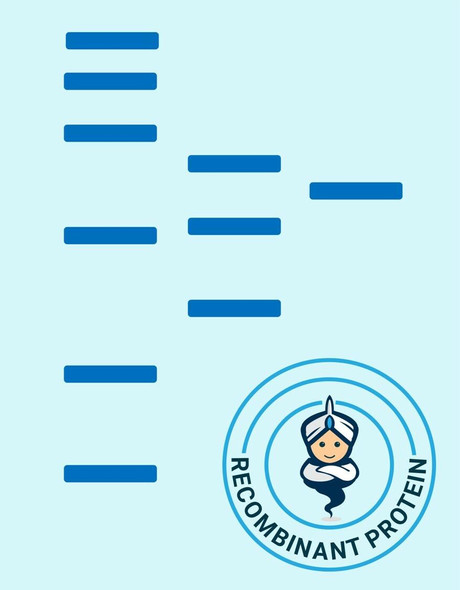Description
| Product Name: | Human GIP Recombinant Protein |
| Product Code: | RPPB3595 |
| Size: | 10µg |
| Species: | Human |
| Target: | GIP |
| Synonyms: | Gastric inhibitory polypeptide, GIP, Incretin hormone. |
| Source: | Escherichia Coli |
| Physical Appearance: | Sterile Filtered colorless solution. |
| Formulation: | The GIP solution (0.25mg/ml) contains 20mM Tris-HCl buffer (pH8.0), 50% glycerol 0.1M NaCl and 2mM DTT. |
| Stability: | Store at 4°C if entire vial will be used within 2-4 weeks. Store, frozen at -20°C for longer periods of time. For long term storage it is recommended to add a carrier protein (0.1% HSA or BSA).Avoid multiple freeze-thaw cycles. |
| Purity: | Greater than 90% as determined by SDS-PAGE. |
| Amino Acid Sequence: | MGSSHHHHHH SSGLVPRGSH MGSEKKEGHF SALPSLPVGS HAKVSSPQPR GPRYAEGTFI SDYSIAMDKI HQQDFVNWLL AQKGKKNDWK HNITQREARA LELAGQANRK EEEAVEPQSS PAKNPSDEDL LRDLLIQELL ACLLDQTNLC RLRSR |
Gastric Inhibitory Polypeptide (GIP) which is a significant hormone of the enteroinsular axis has a functional profile of possible therapeutic value for type 2 diabetes. GIP is an important incretin hormone released into the circulation from endocrine K-cells of the duodenum and jejunum after ingestion of food1. GIP was evaluated for�his ability to elevate cellular cAMP production. GIP promotes plasma triglyceride clearance in response to oral fat loading.
GIP Human Recombinant produced in E. coli is a single polypeptide chain containing 155 amino acids (22-153) and having a molecular mass of 17.3kDa. GIP is fused to a 23 amino acid His-tag at N-terminus & purified by proprietary chromatographic techniques.
| UniProt Protein Function: | GIP: Potent stimulator of insulin secretion and relatively poor inhibitor of gastric acid secretion. Belongs to the glucagon family. |
| UniProt Protein Details: | Protein type:Secreted, signal peptide; Secreted Chromosomal Location of Human Ortholog: 17q21.3-q22 Cellular Component: extracellular space; cell soma; endoplasmic reticulum lumen; extracellular region Molecular Function:hormone activity Biological Process: response to drug; response to peptide hormone stimulus; adult locomotory behavior; positive regulation of insulin secretion; female pregnancy; sensory perception of pain; response to amino acid stimulus; signal transduction; response to lipid; endocrine pancreas development; response to organic cyclic substance; memory; response to starvation; response to selenium ion; cellular protein metabolic process; response to glucose stimulus; response to axon injury; regulation of insulin secretion |
| NCBI Summary: | This gene encodes an incretin hormone and belongs to the glucagon superfamily. The encoded protein is important in maintaining glucose homeostasis as it is a potent stimulator of insulin secretion from pancreatic beta-cells following food ingestion and nutrient absorption. This gene stimulates insulin secretion via its G protein-coupled receptor activation of adenylyl cyclase and other signal transduction pathways. It is a relatively poor inhibitor of gastric acid secretion. [provided by RefSeq, Jul 2008] |
| UniProt Code: | P09681 |
| NCBI GenInfo Identifier: | 121194 |
| NCBI Gene ID: | 2695 |
| NCBI Accession: | P09681.1 |
| UniProt Secondary Accession: | P09681,Q4VB42, Q6NTD3, |
| UniProt Related Accession: | P09681 |
| Molecular Weight: | 153 |
| NCBI Full Name: | Gastric inhibitory polypeptide |
| NCBI Synonym Full Names: | gastric inhibitory polypeptide |
| NCBI Official Symbol: | GIP�� |
| NCBI Protein Information: | gastric inhibitory polypeptide; incretin hormone; glucose-dependent insulinotropic polypeptide |
| UniProt Protein Name: | Gastric inhibitory polypeptide |
| UniProt Synonym Protein Names: | Glucose-dependent insulinotropic polypeptide; Incretin hormone |
| Protein Family: | Gastric inhibitory polypeptide |
| UniProt Gene Name: | GIP�� |
| UniProt Entry Name: | GIP_HUMAN |






